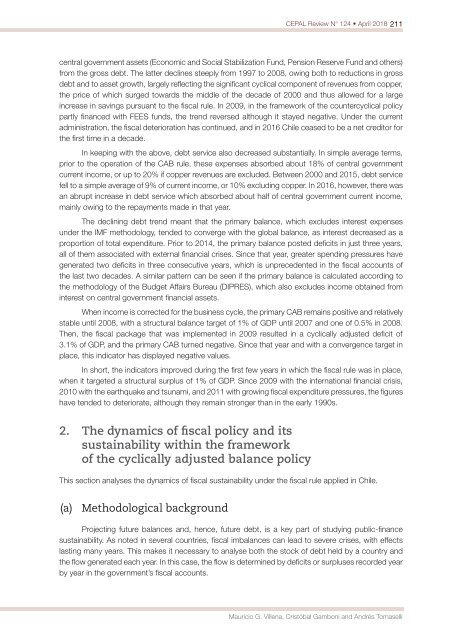CEPAL Review no. 124
April 2018
April 2018
You also want an ePaper? Increase the reach of your titles
YUMPU automatically turns print PDFs into web optimized ePapers that Google loves.
<strong>CEPAL</strong> <strong>Review</strong> N° <strong>124</strong> • April 2018 211<br />
central government assets (Eco<strong>no</strong>mic and Social Stabilization Fund, Pension Reserve Fund and others)<br />
from the gross debt. The latter declines steeply from 1997 to 2008, owing both to reductions in gross<br />
debt and to asset growth, largely reflecting the significant cyclical component of revenues from copper,<br />
the price of which surged towards the middle of the decade of 2000 and thus allowed for a large<br />
increase in savings pursuant to the fiscal rule. In 2009, in the framework of the countercyclical policy<br />
partly financed with FEES funds, the trend reversed although it stayed negative. Under the current<br />
administration, the fiscal deterioration has continued, and in 2016 Chile ceased to be a net creditor for<br />
the first time in a decade.<br />
In keeping with the above, debt service also decreased substantially. In simple average terms,<br />
prior to the operation of the CAB rule, these expenses absorbed about 18% of central government<br />
current income, or up to 20% if copper revenues are excluded. Between 2000 and 2015, debt service<br />
fell to a simple average of 9% of current income, or 10% excluding copper. In 2016, however, there was<br />
an abrupt increase in debt service which absorbed about half of central government current income,<br />
mainly owing to the repayments made in that year.<br />
The declining debt trend meant that the primary balance, which excludes interest expenses<br />
under the IMF methodology, tended to converge with the global balance, as interest decreased as a<br />
proportion of total expenditure. Prior to 2014, the primary balance posted deficits in just three years,<br />
all of them associated with external financial crises. Since that year, greater spending pressures have<br />
generated two deficits in three consecutive years, which is unprecedented in the fiscal accounts of<br />
the last two decades. A similar pattern can be seen if the primary balance is calculated according to<br />
the methodology of the Budget Affairs Bureau (DIPRES), which also excludes income obtained from<br />
interest on central government financial assets.<br />
When income is corrected for the business cycle, the primary CAB remains positive and relatively<br />
stable until 2008, with a structural balance target of 1% of GDP until 2007 and one of 0.5% in 2008.<br />
Then, the fiscal package that was implemented in 2009 resulted in a cyclically adjusted deficit of<br />
3.1% of GDP, and the primary CAB turned negative. Since that year and with a convergence target in<br />
place, this indicator has displayed negative values.<br />
In short, the indicators improved during the first few years in which the fiscal rule was in place,<br />
when it targeted a structural surplus of 1% of GDP. Since 2009 with the international financial crisis,<br />
2010 with the earthquake and tsunami, and 2011 with growing fiscal expenditure pressures, the figures<br />
have tended to deteriorate, although they remain stronger than in the early 1990s.<br />
2. The dynamics of fiscal policy and its<br />
sustainability within the framework<br />
of the cyclically adjusted balance policy<br />
This section analyses the dynamics of fiscal sustainability under the fiscal rule applied in Chile.<br />
(a) Methodological background<br />
Projecting future balances and, hence, future debt, is a key part of studying public-finance<br />
sustainability. As <strong>no</strong>ted in several countries, fiscal imbalances can lead to severe crises, with effects<br />
lasting many years. This makes it necessary to analyse both the stock of debt held by a country and<br />
the flow generated each year. In this case, the flow is determined by deficits or surpluses recorded year<br />
by year in the government’s fiscal accounts.<br />
Mauricio G. Villena, Cristóbal Gamboni and Andrés Tomaselli


















